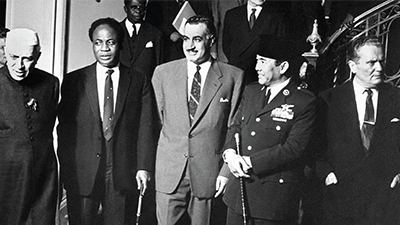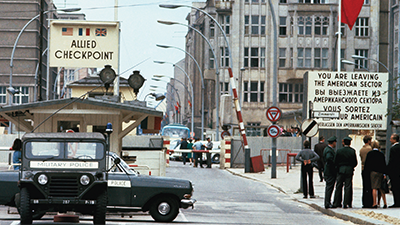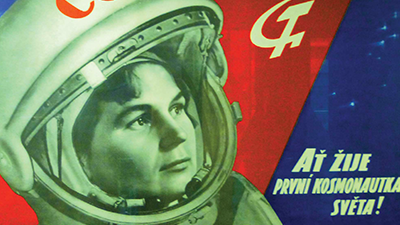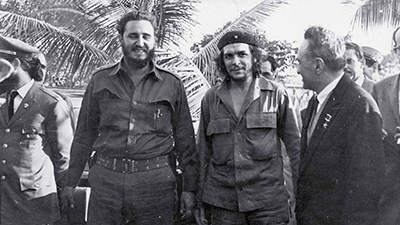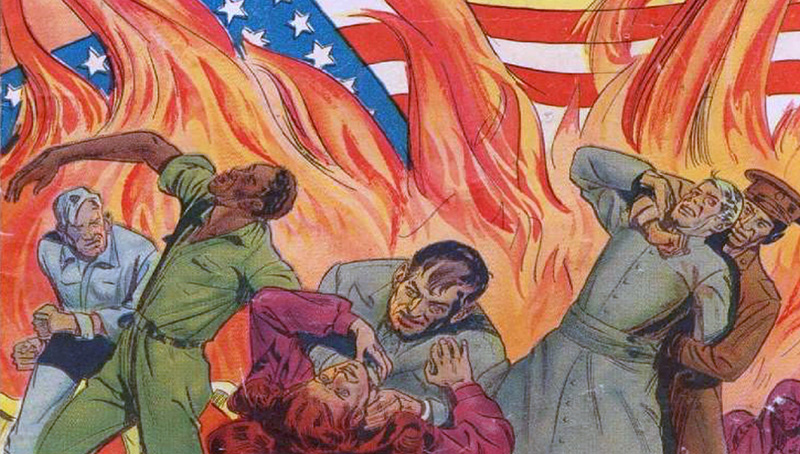The Cold War
Teacher Resources
Driving Question: What were the causes of the Cold War?
In this lesson, you’ll uncover the roots of US–Soviet rivalry, the global consequences of their competition, and the fear of nuclear war that shaped politics, culture, and everyday life. From proxy wars to space races, you’ll examine the causes and costs of a divided world.
Learning Objectives:
- Use evidence to understand how economic and political systems fueled Cold War tensions.
- Evaluate the causes and consequences of the Cold War.
Vocab Terms:
- containment
- ideology
- nuclear
- proliferation
- superpower
Opener: The Cold War
To teach this lesson step, refer to page 2 of the Lesson 8.8 Teaching Guide.
World War I, Russia, and Propaganda provided us a ton of resources for analyzing the past. Learn how other teachers guide students to analyze propaganda material in this Community thread.
The origins of the Cold War revolve around two opposed ideologies. Can you tell what’s capitalism and what’s communism?
What Caused the Cold War?
To teach this lesson step, refer to page 3 of the Lesson 8.8 Teaching Guide.
For reading strategies, take a look at the OER Project Reading Overview.
Dive into the early tensions that sparked the Cold War. Discover how the race for influence, clashing ideologies, and new global challenges reshaped the world after 1945.
-
Guiding Questions
-
Before you read
Preview the questions below, and then skim the article. Be sure to look at the section headings and any images.
While you read
Look for answers to these questions:
- Why did the United States create the Marshall Plan?
- What are the two explanations for the economic recoveries in Germany and Japan?
- How did former colonial powers maintain economic control after independence?
- What strategies did African and Asian leaders use to resist economic dependency?
- Who was left out of postwar prosperity in the United States?
After you read
Respond to this question: How did decolonization and the Cold War together reshape global production and distribution after 1945?
-
Guiding Questions
-
Before you read
Preview the questions below, and then skim the article. Be sure to look at the section headings and any images.
While you read
Look for answers to these questions:
- What was the basic conflict at the center of the Cold War?
- What were the three main features of the Cold War?
- Why did Stalin want greater Soviet influence in Eastern Europe?
- What was the policy of containment?
- What example shows containment in action?
After you read
Respond to this question: Which of the course frames best explains the causes of the Cold War, and why?
Mutually Assured Destruction
To teach this lesson step, refer to page 5 of the Lesson 8.8 Teaching Guide.
The Cold War was a scary time for a lot of people. Review the OER Project Teaching Sensitive Topics in Social Studies Guide as you work through sensitive subject matter with your students.
The Cold War wasn’t just about politics—it was about survival. Learn how the arms and space races fueled global tensions and how leaders navigated the threat of nuclear war.
-
Guiding Questions
-
Before you read
Preview the questions below, and then skim the article. Be sure to look at the section headings and any images.
While you read
Look for answers to these questions:
- What was the arms race?
- What does MAD mean?
- What was the Cuban Missile Crisis?
- How did the Cuban Missile Crisis affect international relations?
- How was the space race linked to the arms race?
After you read
Respond to this question: Do you think the space race offered hope for greater international cooperation, or was it just another extension of Cold War competition? Use evidence to support your answer.
Cold War Timeline
To teach this lesson step, refer to page 7 of the Lesson 8.8 Teaching Guide.
Want to see a Gamified “Who is Winning the Cold War?” Read this thread on the Community Forum.
Cold War rivalries played out in many different regions. These materials examine how local conflicts in Asia, Africa, and Latin America were shaped by global alliances, ideologies, and power struggles.
-
Guiding Questions
-
Before you read
Preview the questions below, and then skim the article. Be sure to look at the section headings and any images.
While you read
Look for answers to these questions:
- What caused bloodshed in South Asia in the late 1940s?
- How did the British government respond to the violence in South Asia?
- How did the partition of South Asia affect the Cold War?
- How did the United States try to contain communism in Latin America?
- Why was the United States concerned about the former Belgian Congo?
After you read
Respond to this question: Which course frame—communities, networks, or production and distribution—best helps explain why the Cold War spread worldwide?
Closer: The Cold War
To teach this lesson step, refer to page 9 of the Lesson 8.8 Teaching Guide.
The Cold War ended in 1991…right? Find answers to this Cold War question by reading this blog from our OER Project historians.
The Cold War had many hot spots. In this activity, you’ll choose one Cold War event and write a breaking news story from a perspective of your choice.
Analyzing Cold War Perspectives
To teach this lesson step, refer to page 10 of the Lesson 8.8 Teaching Guide.
Sharpen your sourcing skills and while you’re at it, develop a deeper understanding of the Cold War's complexities and the varied perspectives of those who lived through it.


